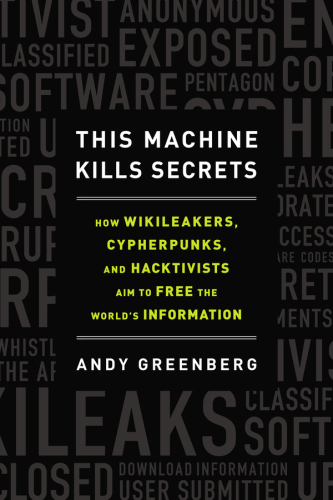
This Machine Kills Secrets
How WikiLeakers, Cypherpunks, and Hacktivists Aim to Free the World's Information
کتاب های مرتبط
- اطلاعات
- نقد و بررسی
- دیدگاه کاربران
نقد و بررسی

August 13, 2012
According to national security officials, the rise of the cypherpunks and other high-tech activists now pose the greatest threat to this country’s defense, a principal theme in this detailed look into superhackers by Greenberg, a staff writer for Forbes magazine. Greenberg includes a rogues’ list of the hackers and cypherpunks who have decided to reveal classified materials and confront the might of the U.S. government, including Pentagon Papers’ Daniel Ellsberg, leaker U.S. Army Pvt. Bradley Manning, code visionaries Tim May and Phil Zimmerman, cypherpunk cofounder Eric Hughes, and Wikileaks cofounder Julian Assange. Leaked secrets have covered such things as dark military secrets, Wall Street mishaps, personal moral defects, and executive coverups. While somewhat focusing on Assange and the inner workings of the secretive Wikileaks, he fully examines the historic development of cryptographic code and online whistle-blowing, along with the ongoing skirmish of NSA vs. the dedicated hackers over the years. With complete access to many of the key hackers and leakers, Greenberg delves eloquently into the magicians of the all-powerful technology that shatters the confidentiality of any and all state secrets while tapping into issues of personal privacy.

July 1, 2012
A wide-ranging look at politically motivated information leaks and the activists behind them. In late 2010, Forbes technology reporter Greenberg sat down with the notorious Julian Assange, founder of WikiLeaks. The resulting interview has been viewed nearly 1 million times on the Forbes website and served as a launching pad for Greenberg's debut book. While the author scatters details of Assange and WikiLeaks throughout the book, Greenberg has larger aims: to catalogue "a revolutionary protest movement bent not on stealing information, but on building a tool that inexorably coaxes it out, a technology that slips inside of institutions and levels their defenses like a Trojan horse of cryptographic software and silicon." With this in mind, the author examines the lives and work of numerous cryptographers, hackers and whistleblowers--some well-known (e.g., Daniel Ellsberg, who first leaked the Pentagon Papers to the New York Times in 1971) and some considerably less so (Birgitta Jonsdottir, Icelandic activist and member of parliament who is behind a push for greater freedom of information there). However, the book bounces between these often-unrelated biographies so frequently that readers get only a vague sense of each person's character. A chapter on the hacker group Anonymous, for example, is based in large part on information from a defunct website and is especially hazy; readers will likely find better information in the recently published We Are Anonymous, by Parmy Olson, who, unlike Greenberg, actually interviewed Anonymous members. Overall, the book's biggest flaw is that its scope is simply too wide. Greenberg valiantly attempts to cover the big picture of information leaks around the globe, but due to the overwhelming cast of characters--as well as some rather dull descriptions of how online cryptography works--the book never fully coalesces. An ambitious overview that ultimately falls flat.
COPYRIGHT(2012) Kirkus Reviews, ALL RIGHTS RESERVED.

April 1, 2012
In the Sixties we marched. Now many young men and women fed up with the government, the military, and the corporations slip into whistleblower mode, anonymously uploading institutional secrets that they feel should be exposed. Think WikiLeaks, Anonymous, and OpenLeaks, and think about the long-term impact, as Forbes reporter Greenberg has us do here.
Copyright 2012 Library Journal, LLC Used with permission.

July 1, 2012
In 1969, it took Daniel Ellsberg more than a year to photocopy the 7,000 pages known as the Pentagon Papers, a highly classified report revealing that the U.S. government had misled the public regarding its involvement in the war in Vietnam. In 2010, in what was the largest intelligence leak in U.S. history, Private Bradley Manning copied hundreds of thousands of classified military and diplomatic files onto a CD labeled Lady GaGa in the time it took to listen to a song before passing it to WikiLeaks. This contrast is at the heart of the leaking and cryptography developments that today allow anonymous whistleblowers to instantly expose government and corporate secrecy. Greenberg first reported on Julian Assange in the November 2010 cover story of Forbes, but with WikiLeaks on life support, there are other players emerging from the shadows of the burgeoning leaking movement, such as the mysterious figure known only as the Architect, an engineer of WikiLeaks who has broken from Assange. Greenberg follows the global movement in exacting detail, and reaction to that movement may range from admiration to rage, depending on where one stands in this polarizing debate.(Reprinted with permission of Booklist, copyright 2012, American Library Association.)

























دیدگاه کاربران